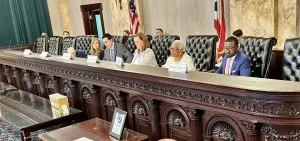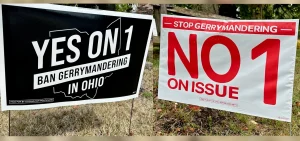News
2024 Year in Review: Ohioans decided on its sixth redistricting ballot issue in 50 years
By: Jo Ingles | Statehouse News Bureau
Posted on:
COLUMBUS, Ohio (Statehouse News Bureau) — Activists frustrated at the multi-year saga of the maps created by the Ohio Redistricting Commission took their plan for an independent map-drawing panel to voters in 2024. But in spite of having momentum and money, the issue failed.

During the first months of the year, Republicans worked on a bill that would ban contributions to ballot issue campaigns by foreign nationals, something they thought would prevent some money from flowing into those who wanted to change the redistricting process. But the legislation stalled. That’s when Gov. Mike DeWine stepped in.
“I’ve waited. I’ve been patient. And my patience has run out,” DeWine told reporters as he announced he was ordering lawmakers to come back in a special session in late spring to pass the legislation. They eventually did.
“This bill does serve the interest of all Ohioans by providing effective and efficient ways of ferreting out illegal foreign donations,” Rep. Bill Seitz (R-Cincinnati) said.
But the bill also included a provision that Seitz warned would not fly; banning green card holders from donating. A suit put the law on hold during a good part of the redistricting campaign.

“This constitutional amendment will restore power to Ohio citizens and take away from the self-serving politicians and their lobbyist friends and big money donors,” O’Connor said. “It will require fair maps in an open and transparent process.”
With enough certified signatures, it was up to the Republican-dominated Ohio Ballot Board to determine the language voters would see on the ballot. And it was a controversial decision. Republican Secretary of State Frank LaRose’s office proposed wording that commission members would be “required to manipulate the boundaries” and referred to those members as unelected people. Sen. Theresa Gavarone (R-Bowling Green) proposed replacing “manipulate” with “gerrymander”, prompting outbursts from the amendment’s supporters.
Citizens Not Politicians sued, but the Republican-dominated Ohio Supreme Court allowed most of the controversial language to stand.
Backers had raised $23 million for their campaign by the time the ballot language was approved. Issue 1’s opponents hadn’t raised nearly that much. But the GOP headwinds were very strong in this election.
And the GOP’s message, and that ballot language adopted by the Republican-dominated Ballot Board, confused voters like Kelly Vogt of Delaware, who said she wanted to vote for Issue 1 but she didn’t.

“The ballot language was confusing and had a huge impact on how people voted,” Citizens Not Politicians spokesman Chris Davey said after Issue 1 failed.
But the red wave that hit Ohio was a huge factor. Republicans won everywhere, including big wins on the Ohio Supreme Court, ousting two Democratic justices and leaving only Justice Jennifer Brunner as the lone Democrat on the court.
Davey said the activists with Citizens Not Politicians are still exploring their options. And Republicans who before the election admitted there are problems with the current process have been largely silent.
During the campaign, DeWine suggested an independent state agency like in Iowa for lawmakers to consider if voters rejected Issue 1. After the election, he said when the new session convenes in January, he’ll ask lawmakers to put the Iowa plan on the ballot for voters to decide. And Sen. Bill Blessing (R-Colerain Twp.) has floated an amendment to expand the legislature as a way to deal with redistricting problems, but it was proposed so late that it didn’t get a hearing.

